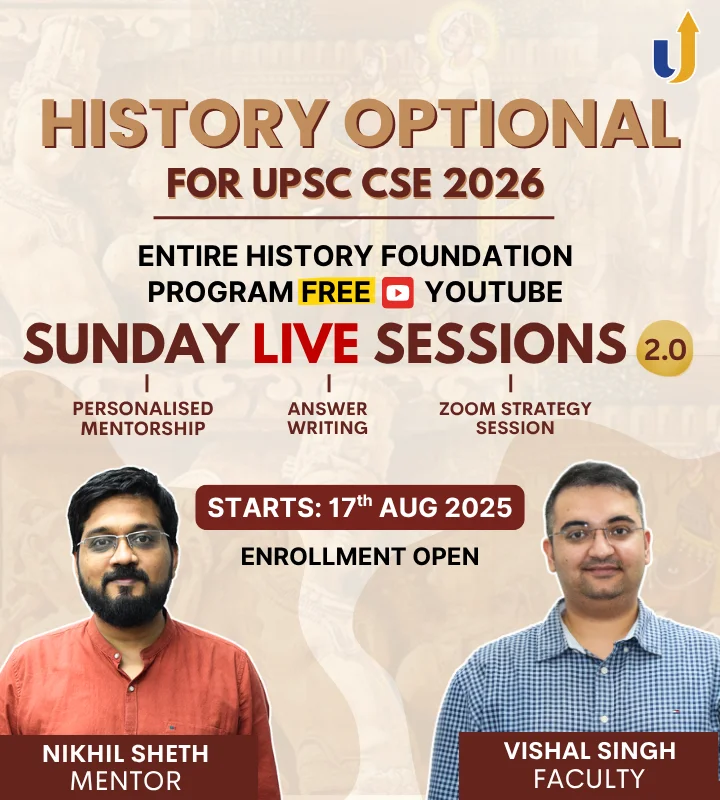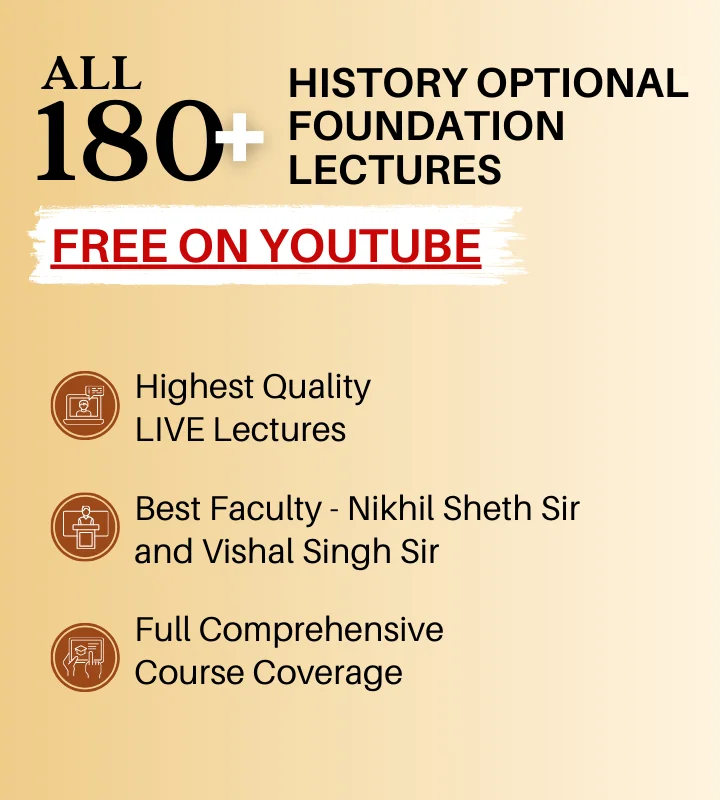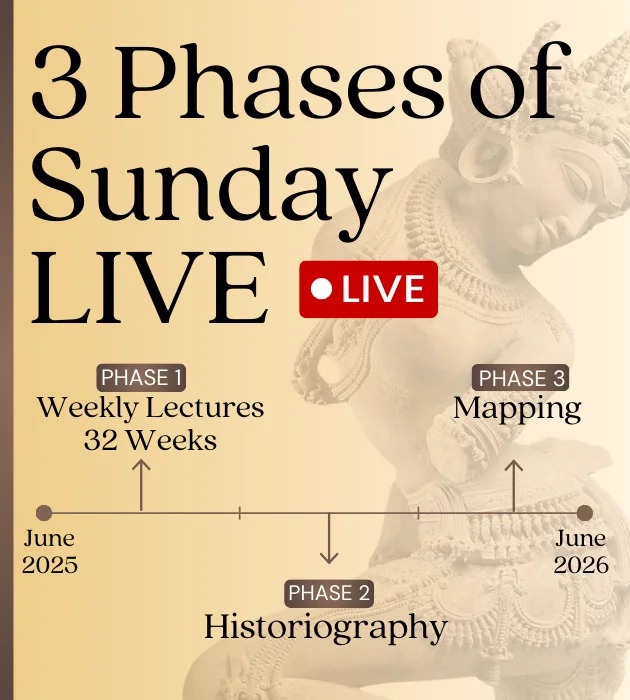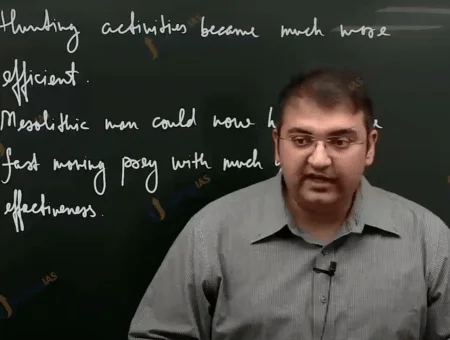

- Start Date: 10th June 2024
- Batch Time: 5:00 PM to 07:30 PM
- Duration: 6 months
- Delivery Mode: Live, Online & Offline
- Offline (100 seats only)
Course Fee
Offline Mode: ₹ 47,000
Online Mode: ₹ 45,000
Comprehensive GS Foundation Program + History Optional
Course Fee
Offline Mode: ₹ 1,40,000
Online Mode: ₹ 1,30,000
Free Foundation Lectures. Weekly Mentorship. Strategic Answer Writing. One Program That Covers It All.
LevelUp IAS offers the most structured History Optional preparation with 180+ FREE foundation lectures and an intensive Sunday LIVE Program focused on answer writing, mentorship, and strategy.
This is not just another lecture series. It’s a year-long, structured program designed to help you build conceptual clarity, develop writing skills, and refine your strategy, guided by best History faculties: Nikhil Sheth Sir and Vishal Singh Sir.
- Lecture Start Date: 1st July 2024
- Sunday LIVE Start Date: 1st August 2024
- Validity: 31st August 2025
History Optional Foundation Lectures
FREE on Youtube
Course Fee
₹ 0
Course Fee
Online / Offline Mode: ₹ 10,000 + GST
GET IN TOUCH
Program Details
- Start Date: 17th August 2025
- Orientation Session On: 11th August 2025
- Validity: 30th June 2026
Delivery Modes
- Online
- Offline
History Optional Foundation Lectures
FREE on Youtube
Course Fee
₹ 0
Course Fee
Online / Offline Mode: ₹ 12,000 + GST
GET IN TOUCH
Got questions? Let's talk!
Fill out the form & connect 1-1 with us
You should join if:
- You have just started History Optional preparation.
- You have done or are currently taking foundation classes elsewhere but need mentorship.
- You want to cover the optional subject through self-study.
- You can’t improve your score in History Optional
- You need guidance and mentorship.
- You want to build writing consistency and score 300+

Sunday LIVE

Full History Optional Foundation Lectures (FREE)
- Comprehensive syllabus coverage
- High Quality 180+ lectures by Nikhil Sir and Vishal Sir
- Recorded format

Exhaustive, Structured and Exam-Focussed Study Material & Notes
- Class notes of entire foundation batch (PDF)
- PYQ booklet (PDF)
- Printed mapping book

Weekly Sessions (Online-Offline)
- 7–8 Ques/Week – Thematic answer writing practice
- Model Answers
- Strategy Sessions
- PYQ Analysis

Personalised Mentorship
- Nikhil sir and Vishal Sir
- Regular Zoom Sessions for doubt resolution

4 Sectional Tests for Practice
- Covers key sections: Ancient, Medieval, Modern, and World History
- Build exam-ready writing skills

Dedicated Mapping Module
- Printed mapping book with 45+ maps
- Content divided in 4 Sections: Prehistory, Proto-history, Historic era, Thematic maps
- Solved PYQs and practice maps
- Recorded lectures

Sunday LIVE
- Weekly Sunday Sessions: Online/ Offline
- Minimum 32 Sessions
- Validity: 30th June 2026
- Personalised Mentorship
- By Nikhil Sir & Vishal Sir
- Thematic Answer Writing
- 7-8 Ques/Week
- Model Answers
- 4 Sectional Tests for Practice
- Dedicated Mapping Module
- Zoom Strategy Session and Doubt sessions
- Access to Student Portal
- Access Notes, Material & Tests
- Download Notes and Handouts
- High-Quality, Based on Original Research
- Model Answers and More
- PYQ Booklet
Enroll Separately for Sunday LIVE
What Sets This Program Apart?
Foundation + LIVE Answer Writing Synergy:
- This isn’t just a test series or mentorship add-on — it’s a strategic blend of comprehensive recorded Foundation lectures with 8 months of structured, LIVE Sunday sessions to ensure active learning and writing mastery throughout your preparation.
Dual Expertise, Single Focus:
- With Nikhil Sheth and Vishal Singh at the helm, you get two subject matter experts teaching in complete alignment — ensuring conceptual clarity and consistent mentoring for both Paper I and Paper II.
Real Mentorship, Not Just Access:
- Unlike programs that claim mentorship and deliver group webinars, here you get actual one-on-one mentorship, real feedback on your writing, and actionable strategy sessions that evolve with your progress.
Deep Integration of Historiography & Debate:
- This program goes beyond factual coverage — it brings you into the world of scholarly debates and historiographical interpretations through special lectures and curated resource sheets to enrich your answers with academic depth.
Practice that Builds Performance:
- Every Sunday session is designed not just to teach but to train — by pushing you to write weekly, reflect, revise, and improve. With detailed feedback and structured guidance, you’re not just practicing — you’re preparing to outperform.
The Mapping Edge, Delivered Right:
- Mapping is often underutilized. Not here. With a dedicated module, print-ready book, and targeted practice, you’ll develop command over one of the most scoring components of the syllabus — and know exactly how to use it in answers.
One Program. Complete Access:
- Your Sunday LIVE enrolment gives you full access to Foundation lectures, notes, tests, mapping module, and mentorship — all integrated to support your preparation from Day 1.





Download AIR 9, Nausheen's Answer Copy
Fill form to download AIR 9, Nausheen's Answer Copy

Watch lectures below to understand our teaching methodology and course structure


High Quality Study Material
- Based on original research
- Carefully curated UPSC-relevant content
- Including the latest books, authors, and events related to the Optional

Note
Syllabus
Refund Policy
- All our lectures are under the license of copyright protection, under the Copyright Act 1957 (the Act), supported by the Copyright Rules 1958 (the Rules), International Copyright Order, 1999 and Copyright Act in 2012. So copying our videos, illegal piracy, downloads, sharing, distribution etc. are strictly not allowed. We will take strict legal action against people doing so.
- We have embedded tracking of video usage with the location, IP and we collect data on the video usage to check if there are any suspicious downloads of video happening with some third-party software. In such cases, the culprits will not be given any warning from our end; instead, strict legal action will be enforced.
- Sharing of the user’s login and password is strictly prohibited. If any student is found doing so, his account would be suspended, and we will file a legal case of data theft and piracy against the student. Please do not share logins with your friends; else you will be in deep trouble.
- There is access limit for each student – based on the course validity (date mentioned in the course features) and the total duration for which a student can watch any particular video (three times of the length of the video). Under no circumstance requests to extend the validity or increase the view duration will be entertained.
- You may be mandatorily required to register the device from which you will be permitted to access the student portal to consume the online services. LevelUP IAS withholds the right to keep the number of devices registered limited.
- Students are advised to have minimum internet speed of 2 Mbps for smooth experience. For mobile, videos run efficiently on 4G networks.
HISTORY
PAPER- I
Ancient India
1. Sources
Archaeological sources:
Exploration, excavation, epigraphy, numismatics, monuments.
Literary sources:
Indigenous: Primary and secondary; poetry, scientific literature, literature, literature in regional languages, religious literature.
Foreign account: Greek, Chinese, and Arab writers.
2. Pre-history and Proto-history:
Geographical factors; hunting and gathering (paleolithic and mesolithic); Beginning of agriculture (neolithic and chalcolithic).
3. Indus Valley Civilization:
Origin, date, extent, characteristics-decline, survival and significance, art and architecture.
4. Megalithic Cultures:
Distribution of pastoral and farming cultures outside the Indus, Development of community life, Settlements, Development of agriculture, Crafts, Pottery, and Iron industry.
5. Aryans and Vedic Period:
Expansions of Aryans in India:
Vedic Period: Religious and philosophic literature; Transformation from Rig Vedic period to the later Vedic period; Political, social, and economical life; Significance of the Vedic Age; Evolution of Monarchy and Varna system.
6. Period of Mahajanapadas:
Formation of States (Mahajanapada): Republics and monarchies; Rise of urban centres; Trade routes; Economic growth; Introduction of coinage; Spread of Jainism and Buddism; Rise of Magadha and Nandas. Iranian and Mecedonian invasions and their impact.
7. Mauryan Empire:
Foundation of the Mauryan Empire, Chandragupta, Kautilya and Arthashastra; Ashoka; Concept of Dharma; Edicts; Polity, Administration, Economy; Art, architecture, and sculpture; External contacts. Religion; Spread of religion; Literature. Disintegration of the empire; sungas and Kanvas.
8. Post-Mauryan Period (Indo-Greeks, Sakas, Kushanas, Western Kshatrapas):
Contact with outside world; growth of urban centres, economy, coinage, development of religions, Mahayana, social conditions, art, architecture, culture, literature, and science.
9. Early State and Society in Eastern India, Deccan, and South India:
Kharavela, The Satavahanas, Tamil States of the Sangam Age; Administration, Economy, land grants, coinage, trade guilds and urban centres; Buddhist centres; Sangam literature and culture; Art and architecture.
10. Guptas, Vakatakas and Vardhanas:
Polity and administration, Economic conditions, Coinage of the Guptas, Land grants, Decline of urban centres, Indian feudalism, Caste system, Position of women, Education, and educational institutions; Nalanda, Vikramshila and Vallabhi, Literature, scientific literature, art and architecture.
11. Regional States during Gupta Era:
The Kadambas, Pallavas, Chalukyas of Badami; Polity and Administration, Trade guilds, Literature; growth of Vaishnava and Saiva religions. Tamil Bhakit movement, Shankaracharya; Vedanta; Institutions of temple and temple architecture; Palas, Senas, Rashtrakutas, Paramaras, Polity and administration; Cultural aspects. Arab conquest of Sind; Alberuni, The Chaluky as of Kalyana, Cholas, Hoysalas, Pandyas; Polity and Administration; Local Government; Growth of art and architecture, religious sects, Institution of temple and Mathas, Agraharas, education and literature, economy and society.
12. Themes in Early Indian Cultural History:
Languages and texts, major stages in the evolution of art and architecture, major philosophical thinkers and schools, ideas in Science and Mathematics.
13. Early Medieval India, 750-1200:
- Polity: Major political developments in Northern India and the peninsula, origin, and the rise of Rajputs.
- The Cholas: administration, village economy and society “Indian Feudalism”.
- Agrarian economy and urban settlements.
- Trade and commerce.
- Society: the status of the Brahman and the new social order.
- Condition of women.
- Indian science and technology.
14. Cultural Traditions in India, 750-1200:
- Philosophy: Skankaracharya and Vedanta, Ramanuja and Vishishtadvaita, Madhva and BrahmaMimansa.
- Religion: Forms and features of religion, Tamil devotional cult, growth of Bhakti, Islam, and its arrival in India, Sufism.
- Literature: Literature in Sanskrit, growth of Tamil literature, literature in the newly developing languages, Kalhan’s Rajtarangini, Alberuni’s India.
- Art and Architecture: Temple architecture, sculpture, Painting.
Medieval India
15. The Thirteenth Century:
- Establishment of the Delhi Sultanate: The Ghurian invasions – factors behind Ghurian success.
- Economic, Social, and cultural consequences.
- Foundation of Delhi Sultanate and early Turkish Sultans.
- Consolidation: The rule of Iltutmish and Balban.
16. The Fourteenth Century:
- “The Khalji Revolution”.
- Alauddin Khalji: Conquests and territorial expansion, agrarian and economic measure.
- Muhammad Tughluq: Major projects, agrarian measures, bureaucracy of Muhammad Tughluq.
- Firuz Tugluq: Agrarian measures, achievements in civil engineering and public works, decline of the Sultanate, foreign contacts, and Ibn Battuta’s account.
17. Society, Culture and Economy in the Thirteenth and Fourteenth Centuries:
- Society: composition of rural society, ruling classes, town dwellers, women, religious classes, caste and slavery under the Sultanate, Bhakti movement, Sufi movement.
- Culture: Persian literature, literature in the regional languages of North India, literaute in the languages of South India, Sultanate architecture and new structural forms, painting, evolution of a composite culture.
- Economy: Agricultural Production, rise of urban economy and non- agricultural production, trade, and commerce.
18. The Fifteenth and Early Sixteenth Century-Political Developments and Economy:
- Rise of Provincial Dynasties: Bengal, Kashmir (Zainul Abedin), Gujarat.
- Malwa, Bahmanids
- The Vijayanagara Empire.
- Lodis.
- Mughal Empire, first phase: Babur, Humayun.
- The Sur Empire: Sher Shah’s administration.
- Portuguese colonial enterprise, Bhakti, and Sufi Movements.
19. The Fifteenth and Early Sixteenth Century- Society and culture:
- Regional cultures specificities.
- Literary traditions.
- Provincial architectural.
- Society, culture, literature, and the arts in Vijayanagara Empire.
20. Akbar:
- Conquests and consolidation of empire.
- Establishment of jagir and mansab systems.
- Rajput Policy.
- Evolution of religious and social Theory of Sulh-i-kul and religious policy.
- Court patronage of art and technology.
21. Mughal Empire in the Seventeenth Century:
- Major administrative policies of Jahangir, Shahjahan and
- The Empire and the Zamindars.
- Religious policies of Jahangir, Shahjahan, and Aurangzeb.
- Nature of the Mughal State.
- Late Seventeenth Century crisis and the revolts.
- The Ahom kingdom.
- Shivaji and the early Maratha Kingdom.
22. Economy and society, in the 16th and 17th Centuries:
- Population Agricultural and craft production.
- Towns, commerce with Europe through Dutch, English and French companies: a trade revolution.
- Indian mercantile Banking, insurance, and credit systems.
- Conditions of peasants, Condition of Women.
- Evolution of the Sikh community and the Khalsa Panth.
23. Culture during Mughal Empire:
- Persian histories and other literature.
- Hindi and religious literatures.
- Mughal architecture.
- Mughal painting.
- Provincial architecture and painting.
- Classical music.
- Science and technology.
24. The Eighteenth Century:
- Factors for the decline of the Mughal Empire.
- The regional principalities: Nizam’s Deccan, Bengal, Awadh.
- Maratha ascendancy under the Peshwas.
- The Maratha fiscal and financial system.
- Emergence of Afghan power Battle of Panipat, 1761.
- State of, political, cultural, and economic, on eve of the British conquest.
PAPER- II
Modern India
1. European Penetration into India:
The Early European Settlements; The Portuguese and the Dutch; The English and the French East India Companies; Their struggle for supremacy; Carnatic Wars; Bengal-The conflict between the English and the Nawabs of Bengal; Siraj and the English; The Battle of Plassey; Significance of Plassey.
2. British Expansion in India:
Bengal-Mir Jafar and Mir Kasim; The Battle of Buxar; Mysore; The Marathas; The three Anglo-Maratha Wars; The Punjab.
3. Early Structure of the British Raj:
The Early administrative structure; From diarchy to direct contol; The Regulating Act (1773); The Pitt’s India Act (1784); The Charter Act (1833); The Voice of free trade and the changing character of British colonial rule; The English utilitarian and India.
4. Economic Impact of British Colonial Rule:
- Land revenue settlements in British India; The Permanent Settlement; Ryotwari Settlement; Mahalwari Settlement; Economic impact of the revenue arrangements; Commercialization of agriculture; Rise of landless agrarian labourers; Impoverishment of the rural society.
- Dislocation of traditional trade and commerce; De-industrialisation; Decline of traditional crafts; Drain of wealth; Economic transformation of India; Railroad and communication network including telegraph and postal services; Famine and poverty in the rural interior; European business enterprise and its limitations.
5. Social and Cultural Developments:
The state of indigenous education, its dislocation; Orientalist-Anglicist controversy, The introduction of western education in India; The rise of press, literature, and public opinion; The rise of modern vernacular literature; Progress of Science; Christian missionary activities in India.
6. Social and Religious Reform Movements in Bengal and Other Areas:
Ram Mohan Roy, The Brahmo Movement; Devendranath Tagore; Iswarchandra Vidyasagar; The Young Bengal Movement; Dayanada Saraswati; The social reform movements in India including Sati, widow remarriage, child marriage etc.; The contribution of Indian renaissance to the growth of modern India; Islamic revivalism-the Feraizi and Wahabi Movements.
7. Indian Response to British Rule:
Peasant movement and tribal uprisings in the 18th and 19th centuries including the Rangpur Dhing (1783), the Kol Rebellion (1832), the Mopla Rebellion in Malabar (1841-1920), the Santal Hul (1855), Indigo Rebellion (1859-60), Deccan Uprising (1875) and the Munda Ulgulan (1899-1900); The Great Revolt of 1857.
— Origin, character, casuses of failure, the consequences; The shift in the character of peasant uprisings in the post-1857 period; the peasant movements of the 1920s and 1930s.
8. Factors leading to the birth of Indian Nationalism; Politics of Association; The Foundation of the Indian National Congress; The Safety-valve thesis relating to the birth of the Congress; Programme and objectives of Early Congress; the social composition of early Congress leadership; the Moderates and Extremists; The Partition of Bengal (1905); The Swadeshi Movement in Bengal; the economic and political aspects of Swadeshi Movement; The beginning of revolutionary extremism in India.
9. Rise of Gandhi; Character of Gandhian nationalism; Gandhi’s popular appeal; Rowlatt Satyagraha; the Khilafat Movement; the Non-cooperation Movement; National politics from the end of the Non-cooperation movement to the beginning of the Civil Disobedience Movement; the two phases of the Civil Disobedience Movement; Simon Commission; The Nehru Report; the Round Table Conferences; Nationalism and the Peasant Movements; Nationalism and Working class movements; Women and Indian youth and students in Indian politics (1885-1947); the election of 1937 and the formation of ministries; Cripps Mission; the Quit India Movement; the Wavell Plan; The Cabinet Mission.
10. Constitutional Developments in the Colonial India between 1858 and 1935.
11. Other strands in the National Movement:
The Revolutionaries: Bengal, the Punjab, Maharashtra, U.P. the Madras Presidency, Outside India.
The Left; The Left within the Congress: Jawaharlal Nehru, Subhas Chandra Bose, the Congress Socialist Party; the Communist Party of India, other left parties.
12. Politics of Separatism; the Muslim League; the Hindu Mahasabha; Communalism and the politics of partition; Transfer of power; Independence.
13. Consolidation as a Nation; Nehru’s Foreign Policy; India and her neighbours (1947-1964); The linguistic reorganisation of States (1935-1947); Regionalism and regional inequality; Integration of Princely States; Princes in electoral politics; the Question of National Language.
14. Caste and Ethnicity after 1947; Backward Castes and Tribes in post- colonial electoral politics; Dalit movements.
15. Economic development and political change; Land reforms; the politics of planning and rural reconstruction; Ecology and environmental policy in post- colonial India; Progress of Science.
World History
16. Enlightenment and Modern ideas:
- Major Ideas of Enlightenment: Kant, Rousseau.
- Spread of Enlightenment in the colonies.
- Rise of socialist ideas (up to Marx); spread of Marxian Socialism.
17. Origins of Modern Politics:
- European States System.
- American Revolution and the Constitition.
- French Revolution and Aftermath, 1789-1815.
- American Civil War with reference to Abraham Lincoln and the abolition of slavery.
- British Democratic politics, 1815-1850: Parliamentary Reformers, Free Traders, Chartists.
18. Industrialization:
- English Industrial Revolution: Causes and Impact on Society.
- Industrialization in other countries: USA, Germany, Russia, Japan.
- Industrialization and Globalization.
19. Nation-State System:
- Rise of Nationalism in 19th century.
- Nationalism: State-building in Germany and Italy.
- Disintegration of Empires in the face of the emergence of nationalities across the World.
20. Imperialism and Colonialism:
- South and South-East Asia.
- Latin America and South Africa.
- Australia.
- Imperialism and free trade: Rise of neo-imperialism.
21. Revolution and Counter-Revolution:
- 19th Century European revolutions.
- The Russian Revolution of 1917-1921.
- Fascist Counter-Revolution, Italy, and Germany.
- The Chinese Revolution of 1949.
22. World Wars:
- 1st and 2nd World Wars as Total Wars: Societal implications.
- World War I: Causes and Consequences.
- World War II: Causes and Consequences.
23. The World after World War II:
- Emergence of Two power blocs.
- Emergence of Third World and non-alignment.
- UNO and the global disputes.
24. Liberation from Colonial Rule:
- Latin America-Bolivar.
- Arab World-Egypt.
- Africa-Apartheid to Democracy.
- South-East Asia-Vietnam.
25. Decolonization and Underdevelopment:
(i) Factors constraining Development; Latin America, Africa.
26. Unification of Europe:
- Post War Foundations, NATO, and European Community.
- Consolidation and Expansion of European Community.
- European Union.
27. Disintegration of Soviet Union and the Rise of the Unipolar World:
- Factors leading to the collapse of Soviet Communism and Soviet Union, 1985-1991.
- Political Changes in East Europe 1989-2001.
- End of the Cold War and US Ascendancy in the World as the lone superpower.
Please find the link to our refund policy below:
At LevelUp IAS, we are committed to providing quality education and ensuring student satisfaction. However, we understand that situations may arise where a refund is necessary. Below are the guidelines for our refund policy:
(1) Refund Eligibility
- Full Refund: Students are eligible for a full refund if they withdraw from the course within the first 7 days after the starting date of the course. The request must be submitted in writing.
- Partial Refund after 7 days:
- General Studies Foundation Program: If a student withdraws after the commencement of the course, then they are eligible for the refund on the pro-rata basis. The details of pro-rata basis are as follows:
- Day 8 to Day 30: Maximum of 75% Refund eligible
- Day 30 to 50% course duration: Maximum of 50% Refund eligible
- After 50% course duration: Zero refund
- Note: duration is measured from the day of commencement of the course and not from the date of admission.
- All other course above course with price of 10,000 (exclusive of GST): If a student withdraws after the commencement of the course, then they are eligible for the refund on the pro-rata basis. The details of pro-rata basis are as follows:
- Day 8 to Day 30: Maximum of 75% Refund eligible
- After Day 30: Zero refund
- Note: duration is measured from the day of commencement of the course and not from the date of admission.
- General Studies Foundation Program: If a student withdraws after the commencement of the course, then they are eligible for the refund on the pro-rata basis. The details of pro-rata basis are as follows:
- Zero Refund: Please note that a student is considered completely ineligible for refunds under following circumstances:
- If the price of a course is less than or equal to Rs. 10,000 (exclusive of GST)
- If admission is done at a discounted price or during promotional offers,
- If admission is done with a partial payment plan with an installment facility.
- It the course is a transferred course from some other original course.
- If the courses are already-recorded modules, then such courses are not eligible for any kind of refund.
(2) Procedure to Request a Refund
- All refund requests must be submitted in writing via email to info@levelupias.com.
- No request made verbally, in person, on phone call, through messages or over any social media platform will be entertained. Only duly emailed requests will be entertained.
- The request must include the student’s name, course name, date of enrolment, and the reason for requesting a refund. Also, a student must attach any additional supporting document of evidence required.
- The date of refund request will be the date on which all the valid documents are received by the institute, which are needed for the approval.
(3) Processing Time
- Institute will take upto 15 days to process the request of the refund, upon complete reception of all the necessary information.
- Thereafter, the refunds will be processed within 15 business days from the date of the refund request approval.
- The refund will be issued using the original payment method unless otherwise agreed upon.
(4) Non-Refundable Fees
- Registration fees, administrative charges, and any other non-tuition fees are non-refundable.
(5) Policy on Course Transfers:
(a) Transfer Type: This policy applies to the following types of course transfers:
- From an online course to an offline course.
- From an offline course to an online course.
- From one course to another course.
- From one individual to another individual.
(b) Transfer Fee: A flat fee of Rs. 10,000 will be charged for any course transfer, regardless of the type of transfer or the specific course involved.
(c) Payment Terms: The transfer fee must be paid in full at the time of the transfer request. The transfer will not be processed until the fee is received.
(d) Non-Refundable: The transfer fee is non-refundable, even if the transfer is later canceled by the student.
(e) Eligibility: Transfers are subject to availability and approval by the institute. The institute reserves the right to deny transfer requests based on course capacity, scheduling conflicts, or other relevant factors.
(6) Amendments
- LevelUp IAS reserves the right to amend this refund policy at any time. Changes will be available for the students through the official website.
For any questions or concerns regarding this refund policy, please contact our administrative office at Contact Us.


